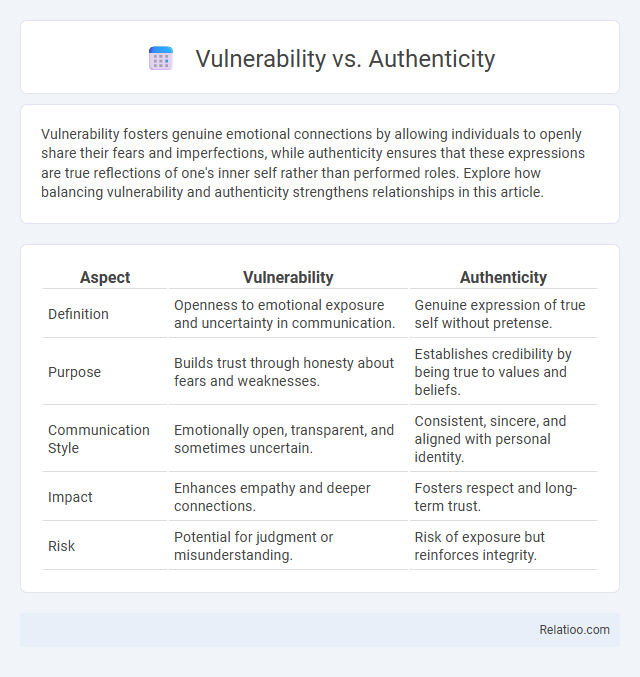Vulnerability fosters genuine emotional connections by allowing individuals to openly share their fears and imperfections, while authenticity ensures that these expressions are true reflections of one's inner self rather than performed roles. Explore how balancing vulnerability and authenticity strengthens relationships in this article.
Table of Comparison
| Aspect | Vulnerability | Authenticity |
|---|---|---|
| Definition | Openness to emotional exposure and uncertainty in communication. | Genuine expression of true self without pretense. |
| Purpose | Builds trust through honesty about fears and weaknesses. | Establishes credibility by being true to values and beliefs. |
| Communication Style | Emotionally open, transparent, and sometimes uncertain. | Consistent, sincere, and aligned with personal identity. |
| Impact | Enhances empathy and deeper connections. | Fosters respect and long-term trust. |
| Risk | Potential for judgment or misunderstanding. | Risk of exposure but reinforces integrity. |
Understanding Vulnerability: Definition and Importance
Understanding vulnerability involves recognizing it as the willingness to expose your true self, including flaws and uncertainties, fostering genuine connections and personal growth. Authenticity depends on embracing vulnerability, as it allows you to present an honest self without masks or pretenses. Prioritizing vulnerability in your relationships and self-awareness cultivates trust and emotional resilience, essential for meaningful and lasting connections.
Authenticity Explained: Being True to Yourself
Authenticity means being true to yourself by embracing your values, emotions, and unique identity without pretense or fear of judgment. Recognizing authentic behavior helps you build deeper connections and gain trust, as it reflects genuine intentions and transparency. Your commitment to authenticity empowers personal growth and fosters resilience in facing challenges.
The Interplay Between Vulnerability and Authenticity
The interplay between vulnerability and authenticity establishes a foundation for genuine connections by encouraging openness and self-expression without fear of judgment. Vulnerability acts as a catalyst that reveals true emotions and experiences, while authenticity ensures these expressions align with one's core identity and values. Together, they foster trust, emotional resilience, and deeper interpersonal relationships, highlighting the importance of embracing imperfections as a pathway to personal growth and connection.
Emotional Risks: Navigating Fear in Vulnerability
Embracing emotional risks during vulnerability requires recognizing the fine line between exposing your true self and protecting your emotional well-being. Authenticity demands courage to face fear without masking feelings, enabling deeper connections and trust. Navigating this balance empowers you to grow emotionally while safeguarding against potential hurt.
Authentic Connections: How Openness Strengthens Relationships
Authentic connections grow stronger when you embrace vulnerability, allowing genuine emotions and thoughts to surface without fear of judgment. This openness fosters trust and deepens emotional bonds, making relationships more resilient and meaningful. Choosing authenticity over superficial interactions invites deeper understanding and lasting intimacy.
Societal Myths: Vulnerability as Weakness vs Strength
Societal myths often misinterpret vulnerability as a weakness, equating openness with fragility and lack of control. In reality, vulnerability demonstrates authenticity, showcasing emotional courage and resilience that foster genuine connections and personal growth. Embracing vulnerability undermines outdated stereotypes, promoting mental health and strengthening interpersonal relationships.
Authenticity in the Workplace: Building Trust and Engagement
Authenticity in the workplace fosters trust by encouraging employees to express their true selves without fear of judgment, leading to deeper connections and higher engagement. Embracing authenticity enhances psychological safety, which promotes open communication and collaborative problem-solving. Organizations that prioritize authenticity experience increased employee satisfaction, retention, and overall productivity.
Overcoming Barriers to Vulnerability
Overcoming barriers to vulnerability requires recognizing the distinction between vulnerability and authenticity, where vulnerability involves openly sharing emotions while authenticity means staying true to your core self. Your ability to confront fear, shame, or judgment allows deeper connections and fosters trust in relationships, which are essential for personal growth. Building resilience against societal pressures and internal doubts enhances your capacity to embrace vulnerability as a courageous act of authenticity.
Personal Growth Through Embracing Authentic Vulnerability
Embracing authentic vulnerability fosters profound personal growth by allowing individuals to connect deeply with their true selves and others, breaking down emotional barriers that hinder self-awareness. This genuine openness cultivates resilience and empathy, essential qualities for navigating life's challenges with confidence. By valuing vulnerability as a strength rather than a weakness, people unlock transformative potential within their personal development journey.
Practical Steps to Cultivate Authenticity and Vulnerability
Cultivating authenticity and vulnerability involves embracing self-awareness through regular reflection and honest self-assessment to recognize true feelings and values. Practice open communication by sharing personal experiences and emotions in safe environments, fostering trust and deeper connections. Set boundaries to protect emotional well-being while remaining open to growth, balancing vulnerability with resilience for sustainable personal development.

Infographic: Vulnerability vs Authenticity
 relatioo.com
relatioo.com